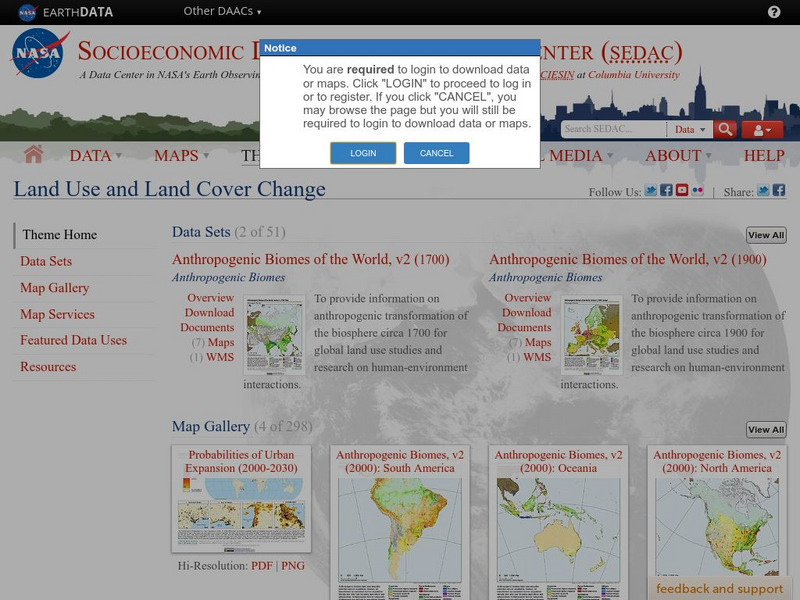Hi, what do you want to do?
Curated OER
Animal Habitats and Their Management
Students review components present for a quality animal habitat and then explore a goose pond to find out what animals reside there. They learn how wildlife managers work with the land so everything can co-exist together.
Curated OER
Science: Trouble in the Troposphere
Students research a NASA Website and record information about an assigned city's tropospheric ozone residual monthly climate. In groups, they graph the information for the past year. They form new groups and compare their city's...
Curated OER
Endangered Species Furniture Project
Middle schoolers work in groups to research an endangered species. They then refinish and paint a piece of furniture and incorporate facts and references about the animal they have researched.
Curated OER
Groundwater Realities
Students review the components of the scientific inquiry method. In groups, they use the internet to research the sustainability of water resources in their community. They examine an environmental impact study, answer questions and...
Curated OER
Spanish Colonization: The Anza Expedition
Students research the Spanish explorations and North American geography. They create web pages based on their study.
Curated OER
Geography of Korea
Students are introduced to the geography of Korea. Using the internet, they identify the weather and climate in the country and create a week weather chart for Korea's four seasons. They complete an interview with a local weatherman...
Curated OER
Here's Looking at You
Students assess some common inherited traits which are easily observable and note their phenotype for the trait. Students compare their phenotypes to those of their parents and attempt to describe the pattern and manor of inheritance.
Curated OER
Ani-mania
Learners view and discuss Robert Harris' farm landscapes and create their own mural out of wood. In groups, they discuss various issues affecting pets throughout the world and create a way to protest or celebrate the issue. They try to...
Curated OER
The Voice of the Individual
Students examine the role of the individual in society as a whole. Individually, they design and create their own calling card as used in the past. They put together an art kit in which they are able to use outdoors. To end the...
Curated OER
People and Parks in the U.S.A.
Fifth graders explore the National Parks in the United States. After locating specified states, 5th graders predict which states have the most National Parks. Given the population of each state, students determine the average acre per...
Curated OER
Internet Research: Methane and Waste
Students conduct Internet research to discover the causes of methane and how to implement a waste action plan. They answer worksheet questions as they search Websites. On the Eduzone site students find information on reducing their own...
Curated OER
Environmental Destruction in Vietnam
Students watch video clip on Environmental Destruction of Vietnam, select and discuss passages from essay, Resuscitation of the Dead Earth, that emphasize destruction to the land, and write essay on whether United States should have been...
Curated OER
Exploring the Maryland State Archives Website
Student demonstrates the ability to organize, manage and comprehend information and applies appropriate skills to collect organize, and interpret data, They then explore an appreciation of media a sources of information and recreation.
Curated OER
Who Can Harvest A Walleye?
Seventh graders investigate the concept of how an ecosystem is put together while conducting research using a variety of resources. They correctly differentiate between a herbivore and carnivore by placing them in the order of hierarchy...
Curated OER
Simple Everyday Products
Fourth graders investigate the origin of products and how they are manufactured from natural resources. They draw the production cycle and discuss how one could help reduce the number of natural resources that are used. They also...
Curated OER
A Quick Look at the Makah Whaling Issue
Students discuss the idea of values and how they are different for different people and cultures. Using the Internet, they read about the Makah whaling issue affecting the Pacific Northwest. They discuss who has the right and authority...
Curated OER
Got Biodiversity?
Learners examine the concept of biodiversity. Using the internet, they complete small activities in which they work together. Using the information they collected, they create a class book, make murals and write in their journals.
Curated OER
Watershed Delineation
Students use topographic maps to delineate a watershed.In this ecology lesson plan, students draw the boundaries of a watershed onto a map using contour lines as a guide. Their resulting maps are used to evaluate their understanding.
Curated OER
The Basics:Life Science
Students explore concepts in life science using segments drawn from Discovery Channel. In this life science lesson, students participate in discussions about the food chain. Students create a poster to illustrate a predator and...
Concord Consortium
Concord Consortium: Gene Environment Interaction: Food and Sand Rat Health
Students explore the effect of both genes and environment on the health of sand rats, a model for studying diabetes in humans.
Ohio Test Prep
Ohio Test Prep: Module 5: Human Geography
Learning module prepares students for the Ohio state Social Studies test on Human Geography. Through tutorial videos, interactive games for review and assessment, students learn about human interaction with their environment, migration,...
Columbia University
Nasa: Sedac: Land Use and Land Cover Change
[Free Registration/Login Required] A collection of twenty-six data sets from SEDAC (Socioeconomic Data and Applications Center) that examine land use and how human activities have impacted on land cover. They look at agriculture, loss of...
University of Texas at Austin
University of Texas: Human Environmental Interactions [Pdf]
Inspired by Hemispheres' 2004 Teachers' Summer Institute, People and Place: Human-Geographic Relations, this curriculum unit was designed to address human adaptation to and modification of the environment. How have humans adjusted to...
Khan Academy
Khan Academy: Key Concepts: Environment and Trade
The resource from Khan Academy provides practice questions for a high school world history course. This section assesses students' knowledge of the environment and its influence on trade.



























![University of Texas: Human Environmental Interactions [Pdf] Lesson Plan University of Texas: Human Environmental Interactions [Pdf] Lesson Plan](https://static.lp.lexp.cloud/images/attachment_defaults/resource/large/FPO-knovation.png)
